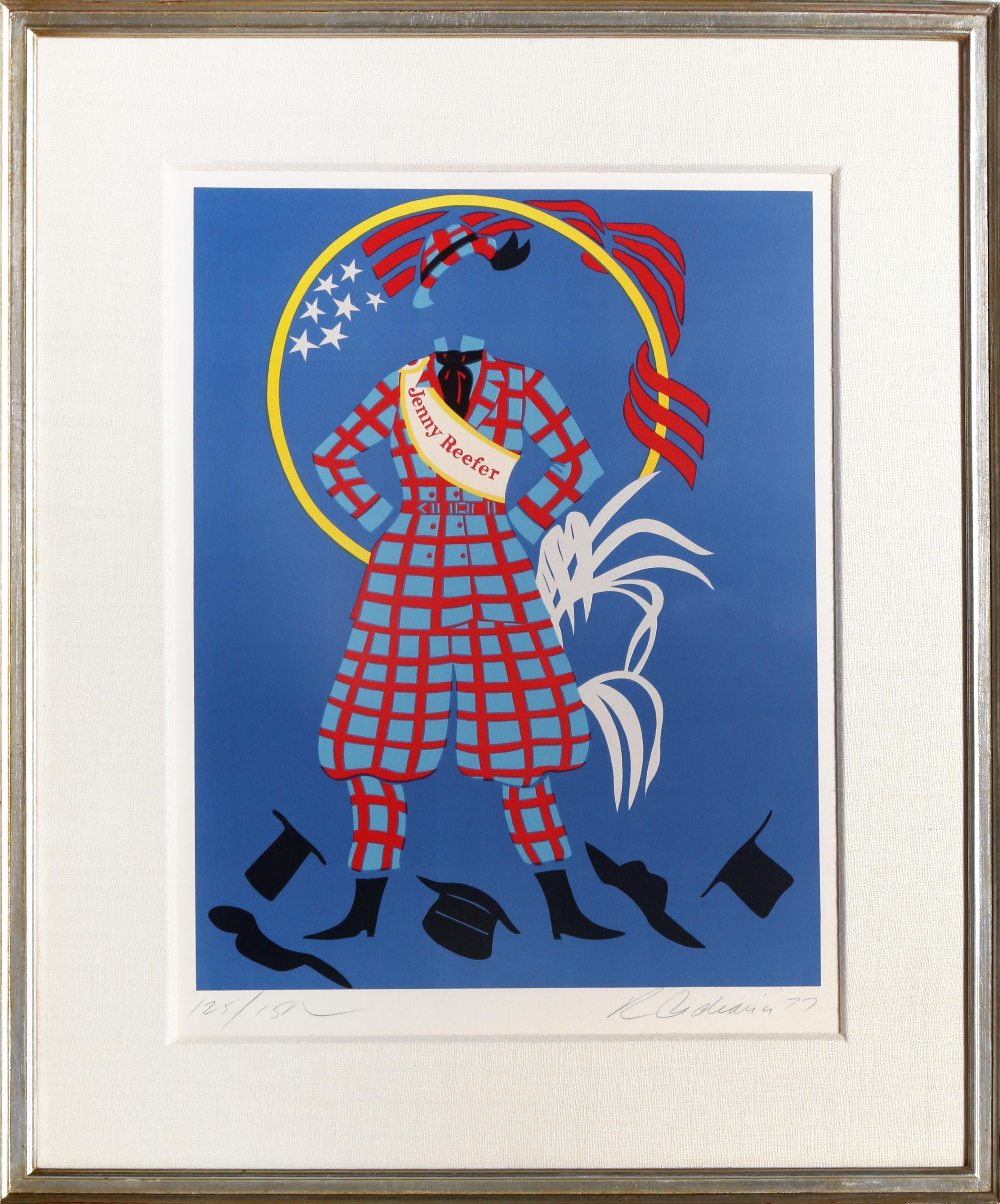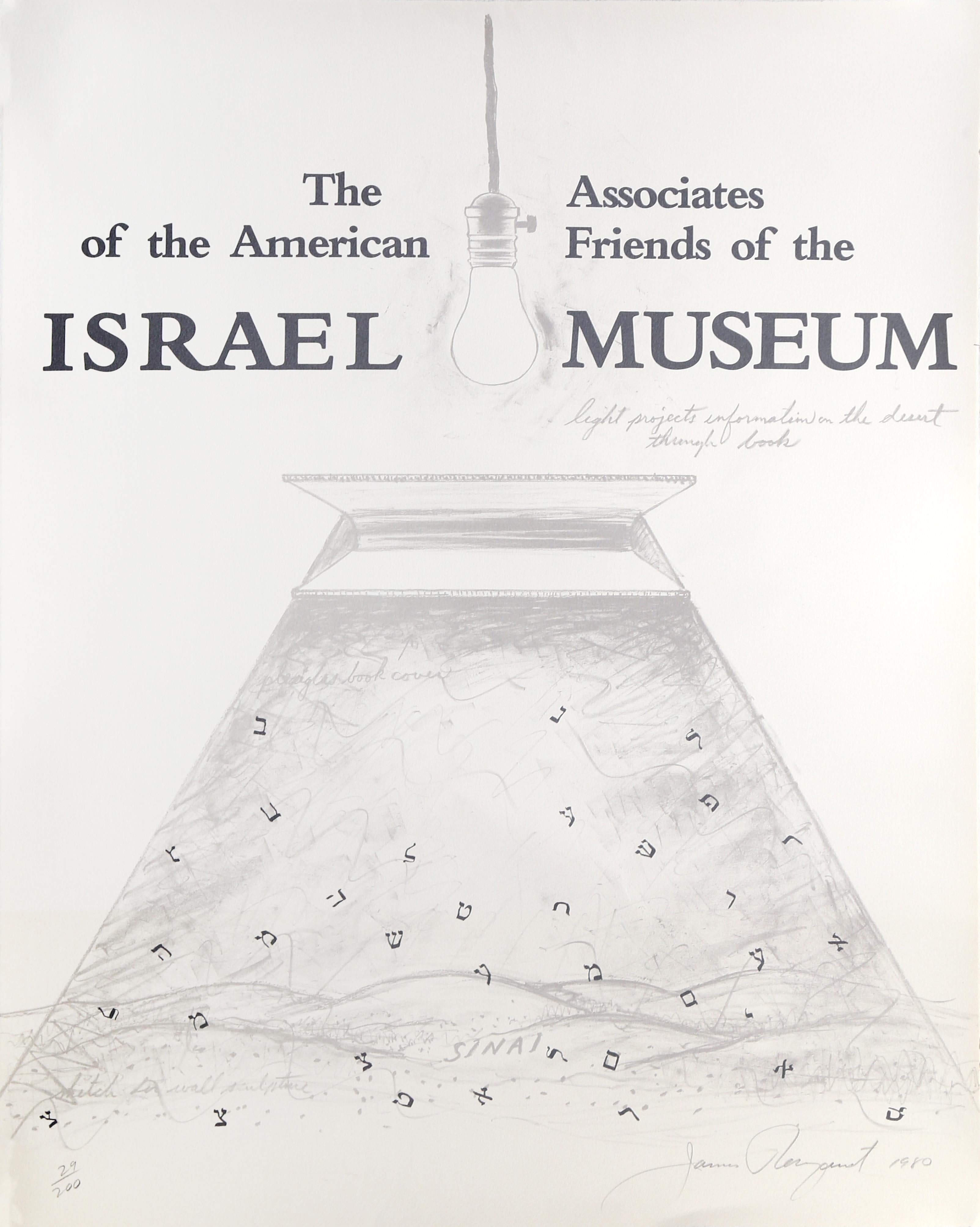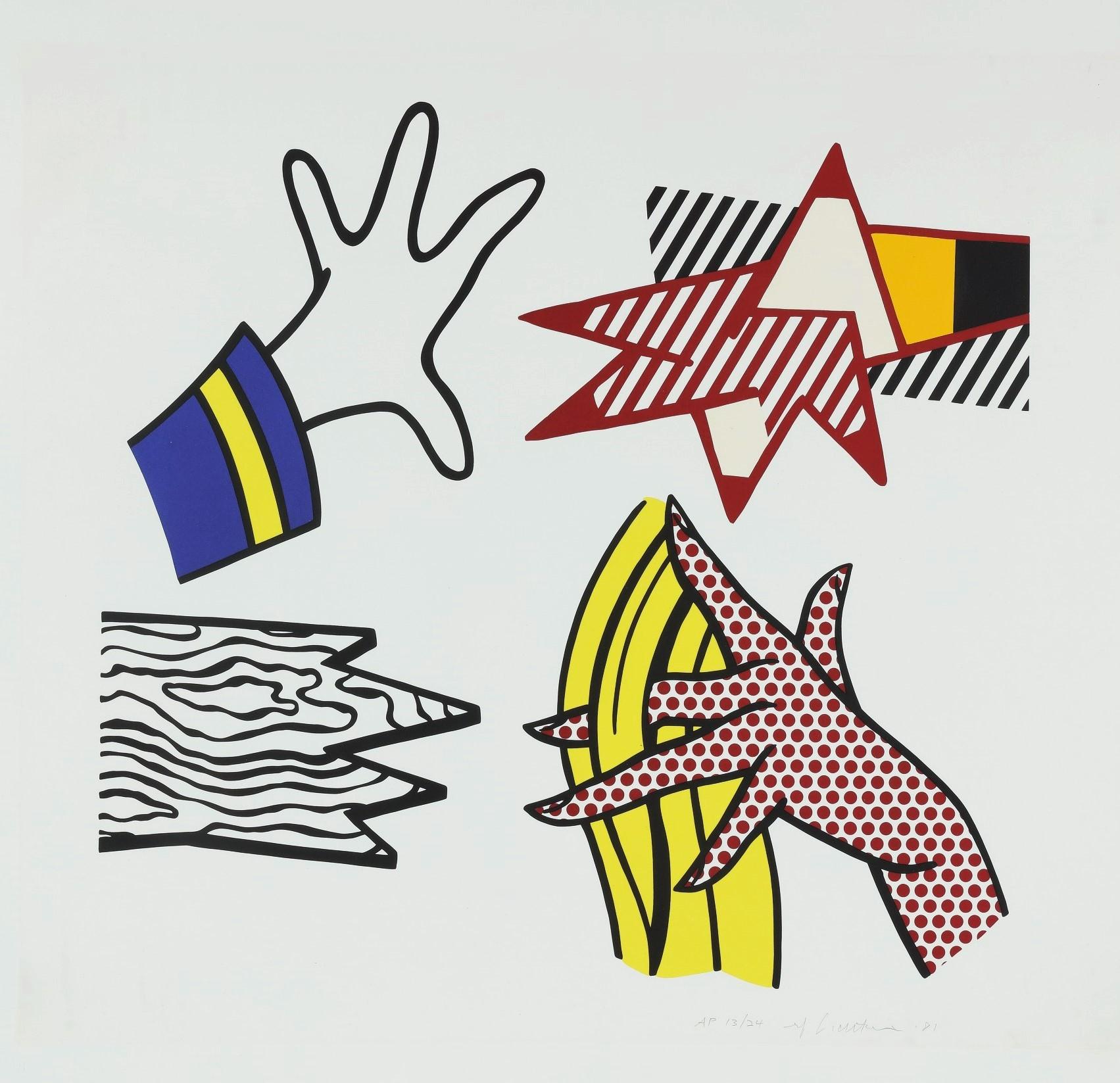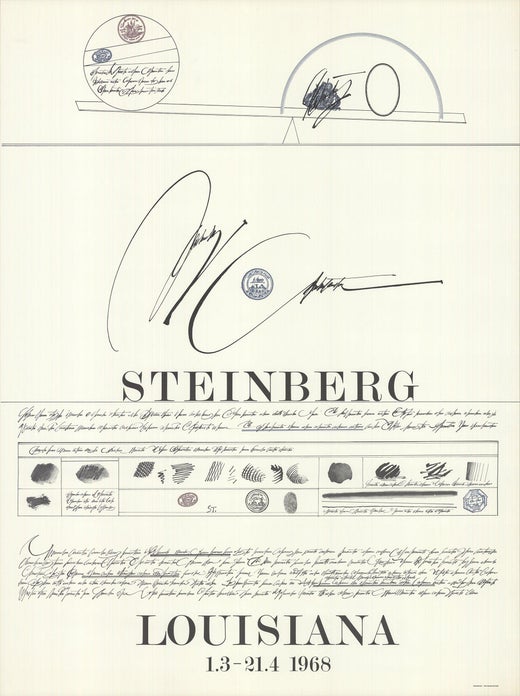Items Similar to Saul Steinberg Lithograph c.1970 (from Derrière le miroir)
Want more images or videos?
Request additional images or videos from the seller
1 of 8
Saul SteinbergSaul Steinberg Lithograph c.1970 (from Derrière le miroir)c.1970
c.1970
About the Item
Saul Steinberg Lithograph Derrière le Miroir:
Lithograph in colors c.1970.
11 x 14 inches.
Very good overall vintage condition with vivid colors.
Unsigned from an edition of unknown.
Derrière le miroir:
In October 1945 the French art dealer Aimé Maeght opens his art gallery at 13 Rue de Téhéran in Paris. His beginning coincides with the end of Second World War and the return of a number of exiled artists back to France.
The publication was created in October 1946 (n°1) and published without interruption until 1982 (n°253). Its original articles and illustrations (mainly original color lithographs by the gallery artists) who were famous at the time.
The lithographic publication covered only the artists exhibited by Maeght gallery either through personal or group exhibitions. Among them were, Pierre Alechinsky, Francis Bacon, Alexander Calder, Marc Chagall, Eduardo Chillida, Alberto Giacometti, Vassily Kandinsky, Ellsworth Kelly, Fernand Léger, Henri Matisse, Joan Miró, Saul Steinberg and Antoni Tapies.
Saul Steinberg was a Romanian cartoonist and illustrator best known for his iconic contributions to The New Yorker magazine. Steinberg’s drawing style is characterized by a playful, childlike-doodle quality while also maintaining an elegant deftness that succinctly described a wide range of subjects. His quirky, sharply observed sketches, at times reminiscent of Dada art, also crossed over into the fine arts world. Along with Arshile Gorky and Robert Motherwell, Steinberg exhibited work at in the landmark “Fourteen Americans” show at The Museum of Modern Art in New York in 1948 and at the Betty Parsons Gallery, which was then at the center of the Abstract Expressionist movement. Born on June 15, 1914 in Râmnicu Sarat, Romania, Steinberg went on to study philosophy at the University of Bucharest but opted not to finish his degree, instead enrolling as an architecture student at the Politecnico di Milano in Milan. Steinberg fled Italy in 1941 with the rise of the anti-Semitic policies, eventually settling in the United States where the artist went on to create over 1,200 drawings for The New Yorker, including 87 covers. Steinberg died on May 12, 1999 in New York, NY.
- Creator:Saul Steinberg (1914-1999, American)
- Creation Year:c.1970
- Dimensions:Height: 11 in (27.94 cm)Width: 14 in (35.56 cm)
- Medium:
- Movement & Style:
- Period:
- Condition:
- Gallery Location:NEW YORK, NY
- Reference Number:1stDibs: LU354314449392
Saul Steinberg
Saul Steinberg was a Romanian American artist, best known for his work for The New Yorker, most notably View of the World from 9th Avenue. He described himself as "a writer who draws
About the Seller
5.0
Vetted Seller
These experienced sellers undergo a comprehensive evaluation by our team of in-house experts.
Established in 2014
1stDibs seller since 2016
4,252 sales on 1stDibs
Typical response time: <1 hour
- ShippingRetrieving quote...Ships From: New York, NY
- Return PolicyA return for this item may be initiated within 2 days of delivery.
More From This SellerView All
- Keith Haring Crack Down! 1986 (vintage program)By Keith HaringLocated in NEW YORK, NYKeith Haring crack down! 1986: Vintage original 1986 Keith Haring illustrated Crack Down! benefit program. This folding pamphlet was designed & illustrated by Keith Haring (along with a poster of same), for the 1986 "Crackdown on Crack" concert at New York City’s world...Category
1980s Pop Art Figurative Prints
MaterialsPaper, Lithograph
- Rare original Raymond Pettibon record cover art set of 4 (Pettibon black flag)By Raymond PettibonLocated in NEW YORK, NYRare original 1980s Raymond Pettibon record cover art: Set of 4 individual Raymond Pettibon illustrated record albums accompanied by their orig...Category
1980s Pop Art Prints and Multiples
MaterialsOffset, Lithograph
- Saul Steinberg lithographic cover c.1969By Saul SteinbergLocated in NEW YORK, NYSaul Steinberg Derrière le Miroir: A lithographic cover published c. 1969. Well suited for framing. A fantastic vintage Saul Steinberg collectible within reach. Lithograph in color...Category
1970s Pop Art Prints and Multiples
MaterialsLithograph
- Saul Steinberg lithograph derrière le miroirBy Saul SteinbergLocated in NEW YORK, NYSaul Steinberg (untitled) Chrysler Building Lithograph from Derrière le miroir: Lithograph in colors c.1970. 11 x 15 inches Very good overall vintage condition. Unsigned from an ed...Category
1970s Pop Art Prints and Multiples
MaterialsLithograph
- Futura 2000 New York 1984 (Futura graffiti artist)By FuturaLocated in NEW YORK, NYFutura 2000 NYC 1984: A rare 1980s Futura announcement card published on the occasion of: FUTURA 2000 at Pizza A Go-Go June 27, 1984; 121 W 31st, New York, NY. Offset printed annou...Category
1980s Pop Art Nude Prints
MaterialsOffset, Lithograph
- 1970s Alexander Calder lithograph (Calder prints)By Alexander CalderLocated in NEW YORK, NY1970s Alexander Calder Lithograph from Derriere le Miroir: Medium: Lithograph in colors. 1975. Dimensions: 15 x 22 inches. Center fold-line as issued; v...Category
1970s Pop Art Figurative Prints
MaterialsLithograph
You May Also Like
- Spectacular : Surprised Girl - Original vintage lithograph poster, Maeght 1976By Jacques MonoryLocated in Paris, FRJacques Monory Spectacular : Surprised Girl, 1976 Original vintage lithograph poster Created for Monory's exhibition at Maeght Gallery On paper 60 x 45 cm (c. 24 x 18 in) Excelle...Category
1970s Pop Art Figurative Prints
MaterialsLithograph
- Careful : Wet Paint - Original lithograph, Handsigned - Limited /150By Valerio AdamiLocated in Paris, FRValerio ADAMI Careful : Wet Paint Original lithograph Handsigned in pencil Numbered /150 On vellum 67.5 x 50 cm (c. 27 x 20 inch) Excellent conditionCategory
1970s Pop Art Figurative Prints
MaterialsLithograph
- "Jenny Reefer" Lithograph by Robert IndianaBy Robert IndianaLocated in Long Island City, NYArtist: Robert Indiana, American (1928 - 2018) Title: Jenny Reefer from Mother of Us All Series Year: 1977 Medium: Lithograph on Arches, signed and numbered in pencil Edition: 125/1...Category
1970s Pop Art Figurative Prints
MaterialsLithograph
- Light Shines Through a Book on the SinaiBy James RosenquistLocated in Long Island City, NY"Light Shines Through a Book on the Sinai" is an original lithograph by James Rosenquist to benefit The Associates of the American Friends of Israel Museum in 1980. The print is sign...Category
1980s Pop Art Figurative Prints
MaterialsLithograph
- Study of HandsBy Roy LichtensteinLocated in New York, NYCreated in 1981 as an original lithograph with screen-printing, Roy Lichtenstein’s, Study of Hands is hand-signed in pencil, dated and numbered, measuring 31 ¼ x 32 ¾ in. (79.5 x 83....Category
20th Century Pop Art Figurative Prints
MaterialsLithograph, Screen
- 1971 Modernist Lithograph Redhead Pop Art Mod Fashionable Woman Richard LindnerBy Richard LindnerLocated in Surfside, FLRICHARD LINDNER (American. 1901-1978) Hand Signed limited edition lithograph with blindstamp Publisher: Shorewood-Bank Street Atelier for the Skowhegan School of Painting and Sculpture 29.25 X 22 inches Richard Lindner was born in Hamburg, Germany. In 1905 the family moved to Nuremberg, where Lindner's mother was owner of a custom-fitting corset business and Richard Lindner grew up and studied at the Kunstgewerbeschule (Arts and Crafts School since 1940 Academy of Fine Arts). From 1924 to 1927 he lived in Munich and studied there from 1925 at the Kunstakademie. In 1927 he moved to Berlin and stayed there until 1928, when he returned to Munich to become art director of a publishing firm. He remained there until 1933, when he was forced to flee to Paris, where he became politically engaged, sought contact with French artists and earned his living as a commercial artist. He was interned when the war broke out in 1939 and later served in the French Army. In 1941 he went to the United States and worked in New York City as an illustrator of books and magazines (Vogue, Fortune and Harper's Bazaar). He began painting seriously in 1952, holding his first one-man exhibit in 1954. His style blends a mechanistic cubism with personal images and haunting symbolism. LIndner maintained contact with the emigre community including New York artists and German emigrants (Albert Einstein, Marlene Dietrich, Saul Steinberg). Though he became a United States citizen in 1948, Lindner considered himself a New Yorker, but not a true American. However, over the course of time, his continental circus women became New York City streetwalkers. New York police uniforms replaced European military uniforms as symbols of authority.At a time when Abstract Expressionism was all the rage, Lindner’s painting went against the current and always kept its distance. His pictorial language of vibrant colours and broad planes of colour and his urban themes make him a forerunner of American Pop Art. At the same time, he owes the critical tone of his paintings to the influence of European art movements such as Neue Sachlichkeit and Dada. His first exhibition did not take place until 1954, by which time he was over fifty, and, interestingly, it was held at the Betty Parsons Gallery in New York, a venue associated with the American Expressionists. From 1952 he taught at the Pratt Institute, Brooklyn, from 1967 at Yale University School of Art and Architecture, New Haven. In 1957 Lindner got the William and Norma Copley Foundation-Award. In 1965 he became Guest Professor at the Akademie für Bildende Künste, Hamburg. His Ice (1966, Whitney Museum of American Art) established a connection between the metaphysical tradition and pop art. He did work on Rowlux which was used by a number of pop artists (most notably Roy Lichtenstein)The painting shows harsh, flat geometric shapes framing an erotic but mechanical robot-woman. His paintings used the sexual symbolism of advertising and investigated definitions of gender roles in the media. While influencing Pop Art (Andy Warhol, Tom Wesselmann and Claes Oldenburg amongst others) his highly colourful, hard-edge style seems to have brought him close to Pop Art, which he rejected. Nevertheless, he is immortalised on the cover of the Beatles record "Sgt. Pepper’s Lonely Hearts Club Band" (1967) as a patron of the pop culture. He also did a tapestry banner with the Betsy Ross Flag...Category
1970s Pop Art Abstract Prints
MaterialsLithograph
Recently Viewed
View AllMore Ways To Browse
Worlds End 1982
Vintage October
C C Milano
Vintage Sketches
Miro Italy
Giacometti Original
Matisse 1948
New Yorker Cover Art
The New Yorker Covers
Cross N
Kelly 1970
New Yorker Cover
Gorky Arshile
Marc Chagall Illustrations
Chagall Lithograph In Colors
New Yorker Magazine Covers
The New Yorker Magazine Cover
Vintage Matisse Print




